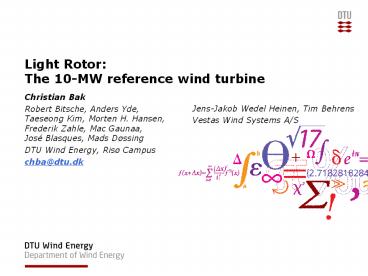Light Rotor: The 10-MW reference wind turbine - PowerPoint PPT Presentation
Title:
Light Rotor: The 10-MW reference wind turbine
Description:
Background. Wind turbines and rotors aregrowing in size. Severalinvestigations have beencarried out to reveal the result of upscaling. Wind turbine ... – PowerPoint PPT presentation
Number of Views:129
Avg rating:3.0/5.0
Title: Light Rotor: The 10-MW reference wind turbine
1
Light RotorThe 10-MW reference wind turbine
Jens-Jakob Wedel Heinen, Tim Behrens Vestas Wind
Systems A/S
- Christian Bak
- Robert Bitsche, Anders Yde, Taeseong Kim, Morten
H. Hansen, Frederik Zahle, Mac Gaunaa, José
Blasques, Mads Døssing - DTU Wind Energy, Risø Campus
- chba_at_dtu.dk
2
Background
- Wind turbines and rotors are growing in size
- Several investigations have been carried out to
reveal the result of upscaling - Wind turbine mass will with direct upscaling
increase with (rotor radius)3 - The power will only increase with (rotor radius)2
- The gravity will have an increasing impact on the
loads - An obvious question is therefore
- How should the power of 3 for the wind turbine
mass be reduced in the process of upscaling? - More specifically How should the power of 3 for
the blade mass be reduced? - That is the reason for establishing a project to
investigate this issue.
EWEA Conference, 2012
3
Background
- The Light Rotor project is a cooperation
between DTU Wind Energy and Vestas - The objective is to develop the basis for design
of wind turbine blades for use on 10MW rotors
with lower weight, tailored aeroelastic response
and optimized aerodynamic efficiency. - This will be achieved by developing and applying
a combination of thick airfoils, blade sweep and
optimized structure
Existing techniques and methods
New techniques and methods
Add Presentation Title in Footer via Insert
Header Footer
EWEA Conference, 2012
4
This presentation
- This presentation is about the development of a
10MW reference wind turbine, where future light
weight designs can be compared - This 10MW reference wind turbine is not expected
to be an exceptional light weight construction,
but rather a fair upscaling of an existing wind
turbine - The presented turbine is iteration 2 in the
design process and not the final design
EWEA Conference, 2012
5
Outline
- Basic considerations
- The method
- Results from the LR10-MW turbine
- Aerodynamic design
- Structural design
- Aeroelastic stability
- Loads
- Conclusions
EWEA Conference, 2012
6
Basic considerations
Turbine V90-3.0MW V112-3.0MW V164-7.0MW Artificial 5MW reference
Specific power W/m2 472 305 331 407
R89.17m
RNA mass629tons
EWEA Conference, 2012
7
The method
- FFA-W3-xxx airfoils. 24.1 to 36.0 relative
thickness, 60 airfoil scaled from FFA-W3-360 and
cylinder. - XFOIL computations at Re 9x106 to 13x106 3D
corrected - HAWTOPT numerical optimizations. Max tip speed
80m/s, l8.06, min relative airfoil thickness
24.1 - ABAQUS (6.11) FEM computations. Uniaxial, biaxial
and triaxial laminates were used together with
PVC foam as sandwich core material - HAWCSTAB2 (aero-servo-elastic stability tool) and
HAWC2 (aeroelastic code) computations. Class IA
according to IEC-61400-1 standard for offshore
application - Iteration 2 is presented
EWEA Conference, 2012
8
The LR10-MW turbine Aerodynamic designHAWTOPT
EWEA Conference, 2012
9
The LR10-MW turbine Structural blade
designABAQUS
Mode Number FrequencyHz Remark
1 0.5210 First flapwise
2 0.8820 First edgewise
3 1.6142 Second flapw.
4 2.8173 Second edgew.
5 3.4027 Third flapwise
6 5.0342 First torsional
EWEA Conference, 2012
10
The LR10-MW turbine Blade mass
LR10MW blade Mass47.9tons
EWEA Conference, 2012
11
The LR10-MW turbine Aeroelastic
stabilityHAWCSTAB2
EWEA Conference, 2012
12
The LR10-MW turbine Aeroelastic
stabilityHAWCSTAB2
EWEA Conference, 2012
13
The LR10-MW turbine LoadsHAWC2
EWEA Conference, 2012
14
Conclusions
- A rotor and a wind turbine for a 10-MW wind
turbine are designed with the shown results for
Iteration 2 in the design process. - The design process will need more iterations
between aerodynamic, structural and aeroelastic
design. - It is of primary importance to design the rotor
together with the entire system Foundation,
tower, drivetrain and rotor. - Several issues were highlighted
- Selecting the specific power is not trivial. For
this rotor it was chosen to maintain the specific
power of the artificial 5-MW wind turbine. - The mass of the LR10-MW blade seems to be
somewhat too high compared to a blade directly
upscaled from e.g. LM73.5P. - Estimating the drive train mass is not trivial
- The mass of the turbine is highly depending on
concepts/technology - In the further work, the challenges in the
control needs to be solved. - Also, the balance between power performance,
loads and structural layout will be investigated
further resulting in changes in the present
design.
EWEA Conference, 2012
15
Availability
- The final design incl. aeroelastic model and
blade layout will be available on - www.vindenergi.dtu.dk
- under the menu Research
- from July 1, 2012
EWEA Conference, 2012
16
Acknowledgements
- Thanks to the Danish Energy Agency for partly
funding the EUDP 2010-1 Light Rotor project
EWEA Conference, 2012
17
Thank you for the attention!































